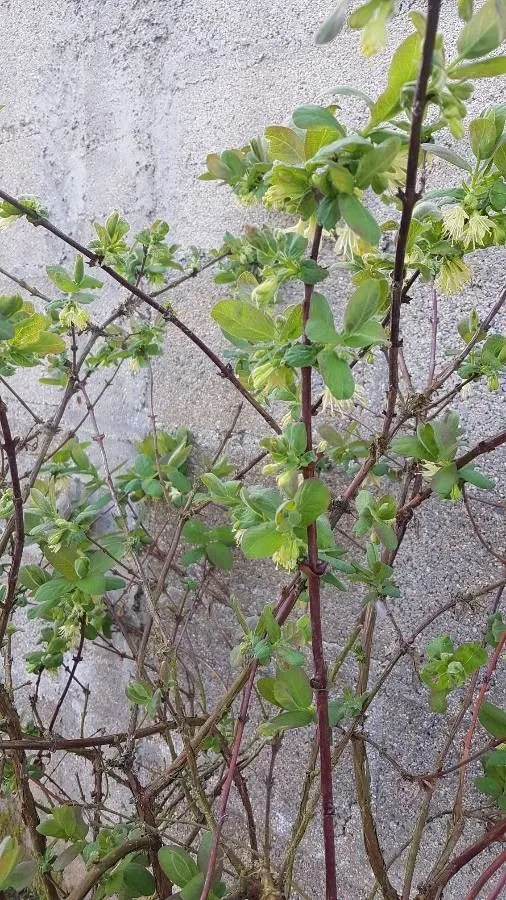
Author: L.
Bibliography: Sp. Pl.: 174 (1753)
Year: 1753
Status: accepted
Rank: species
Genus: Lonicera
Vegetable: False
Observations: Temp. Eurasia
Blue honeysuckle, known scientifically as Lonicera caerulea, is a species belonging to the Caprifoliaceae family. This remarkable plant was first described in the seminal work “Species Plantarum” by Carl Linnaeus in 1753.
Native to the temperate regions of Eurasia, blue honeysuckle thrives in climates that provide it with the seasonal changes it needs for optimal growth. The plant is well-adapted to survive cold temperatures, making it a resilient and hardy addition to gardens in cooler climates.
Its common name is derived from the stunning blue berries it produces. These berries, which appear in the late spring and early summer, are not only visually striking but also edible. They have been valued for their sweet-tart flavor and nutritional properties. Blue honeysuckle berries are rich in antioxidants and vitamins, making them a popular choice for both fresh consumption and culinary use in jams, jellies, and desserts.
The plant itself is a deciduous shrub, typically reaching heights of 1.5 to 2 meters. It features slender, upright stems and simple, opposite leaves that are green to bluish-green in color. In addition to its ornamental berries, blue honeysuckle also produces small, tubular flowers that range in color from white to pale yellow. These flowers, blooming in early spring, attract various pollinators, including bees and butterflies, contributing to the biodiversity of the area.
Blue honeysuckle can be cultivated in a variety of soil types, provided they are well-drained. It performs best in full sunlight but can tolerate partial shade. Gardeners appreciate its low maintenance and its ability to attract wildlife while providing an early spring harvest of nutritious berries.
Overall, Lonicera caerulea is a versatile and attractive plant that offers both aesthetic and practical benefits. Whether grown for its decorative appeal or its delicious fruit, blue honeysuckle is a valuable addition to any garden.
Deu: blaue heckenkirsche
Eng: blue honeysuckle, blueberry honeysuckle, fly honeysuckle, sweetberry honeysuckle, blue fly-honeysuckle, blue-berried honeysuckle, western honeysuckle
Swe: bägarkrokus, grekisk krokus, toscanakrokus, blåtry, sinikuusama, rysk blåtry, vanlig blåtry
Lit: melsvauogis sausmedis
Lav: pallasa sausserdis
Nob: blåleddved
Nno: blåleddved
Fra: camérisier bleu, chèvrefeuille à fruits bleus, chèvrefeuille bleu
Fin: sinikuusama
Sme: čuolbmamuorra
En: Blue honeysuckle, Fly honeysuckle, Blueberry honeysuckle, Sweetberry honeysuckle, Deepblue honeysuckle, Blue-berried Honeysuckle, Blue fly-honeysuckle, Western honeysuckle, Sweet-berry Honeysuckle
Ar: عسلة زرقاء
Hy: Ցախակեռաս կապույտ
Be: Бружмель сіні
Zh: 蓝靛果忍冬, 藍果忍冬, 藍靛果, 藍靛果忍冬
Hr: Plava kozokrvina
Cs: Zimolez modrý
Da: Blåfrugtet Gedeblad
Nl: Blauwe Kamperfoelie
Et: Sinine kuslapuu
Fi: Sinikuusama
Fr: Camérisier bleu, Chèvrefeuille Bleu, Chèvrefeuille à fruits bleus
De: Blaue Heckenkirsche, Blaue Doppelbeere, Blaues Geißblatt
He: יערה כחולה
Hu: Kék mézbogyó
Is: Blátoppur
It: Caprifoglio (Madreselva) turchino, Caprifoglio turchino, Madreselva turchina
Ja: Ke-yonomi
Ko: 댕댕이나무
Lv: Pallasa sausserdis
Lt: Melsvauogis sausmedis
Se: Čuolbmamuorra
No: Blåleddved
Nb: Blåleddved
Nn: Blåleddved
Pl: Jagoda Kamczacka, Wiciokrzew Siny
Ru: Žimolost’ Golbuaâ, Жимолость голубая
Sr: Sibirska borovnica (haskap)
Es: Madreselva Azul, Modro kosteničevje
Sv: Blåtry, Bägarkrokus, Grekisk krokus, Toscanakrokus, Sinikuusama, Rysk blåtry, Vanlig blåtry
Zh-tw: 藍靛果忍冬
Zh-hant: 藍靛果忍冬
Uk: Жимолость блакитна
Taken May 3, 2021 by Sławomir C (cc-by-sa)
Taken Apr 28, 2021 by Tomek (cc-by-sa)
Taken May 17, 2021 by Mallol Camprubí Albert (cc-by-sa)
Taken Aug 26, 2019 by Brena Danilo (cc-by-sa)
Taken Mar 20, 2020 by Karim Amziane (cc-by-sa)
Taken Apr 13, 2015 by Andrzej Konstantynowicz (cc-by-sa)
Taken Apr 13, 2015 by Andrzej Konstantynowicz (cc-by-sa)
Taken Apr 24, 2008 by Andrzej Konstantynowicz (cc-by-sa)
Taken Jul 9, 2001 by Tela Botanica − Liliane Roubaudi (cc-by-sa)
Taken Mar 20, 2020 by Karim Amziane (cc-by-sa)
Taken Jul 11, 2015 by Tela Botanica − Yoan MARTIN (cc-by-sa)
Taken Jul 15, 2016 by Tela Botanica − Yoan MARTIN (cc-by-sa)
Taken Jul 15, 2016 by Tela Botanica − Yoan MARTIN (cc-by-sa)
Taken Aug 27, 2021 by Michaela Wimmer (cc-by-sa)
Taken Mar 20, 2020 by Karim Amziane (cc-by-sa)
Taken May 26, 2020 by sarah ramsden (cc-by-sa)
Taken Mar 10, 2019 by Marcela Parra (cc-by-sa)
Taken Sep 22, 2022 by Anne-laure Bauduin (cc-by-sa)
Taken Aug 15, 2022 by Treize (cc-by-sa)
Taken Jul 11, 2015 by Tela Botanica − Yoan MARTIN (cc-by-sa)
Taken Aug 27, 2021 by Michaela Wimmer (cc-by-sa)
Taken Jun 11, 2021 by Наталья Голубкина (cc-by-sa)
Taken Jul 2, 2018 by Halbe Marianne (cc-by-sa)
Taken Jun 14, 2021 by Noémie Labranche-Montion (cc-by-sa)
Taken Jul 10, 2021 by Michel G (cc-by-sa)
Taken Jul 10, 2007 by Tela Botanica − Michel POURCHET (cc-by-sa)
Taken Jul 10, 2007 by Tela Botanica − Michel POURCHET (cc-by-sa)
Taken Jul 10, 2007 by Tela Botanica − Michel POURCHET (cc-by-sa)
Taken Jan 1, 1970 by Photoflora – L’Abbé COSTE (©)
Taken Aug 5, 2019 by Pe Roberta (cc-by-sa)
© copyright of the Board of Trustees of the Royal Botanic Gardens, Kew.
© copyright of the Board of Trustees of the Royal Botanic Gardens, Kew.
© copyright of the Board of Trustees of the Royal Botanic Gardens, Kew.
Growth habit: Shrub
Ph maximum: 5.0
Ph minimum: 4.5
Light: 6
Atmospheric humidity: 8
Bloom months: [‘may’, ‘jun’, ‘jul’]
Soil nutriments: 3
Family: Myrtaceae Author: (F.Muell.) K.D.Hill & L.A.S.Johnson Bibliography: Telopea 6: 402 (1995) Year: 1995 Status:…
Family: Rubiaceae Author: Pierre ex A.Froehner Bibliography: Notizbl. Bot. Gart. Berlin-Dahlem 1: 237 (1897) Year:…
Family: Sapindaceae Author: Koidz. Bibliography: J. Coll. Sci. Imp. Univ. Tokyo 32(1): 38 (1911) Year:…
Family: Asteraceae Author: A.Gray Bibliography: Pacif. Railr. Rep.: 107 (1857) Year: 1857 Status: accepted Rank:…
Family: Fabaceae Author: Medik. Bibliography: Vorles. Churpfälz. Phys.-Ökon. Ges. 2: 398 (1787) Year: 1787 Status:…
Family: Aspleniaceae Author: (Cav.) Alston Bibliography: Bull. Misc. Inform. Kew 1932: 309 (1932) Year: 1932…